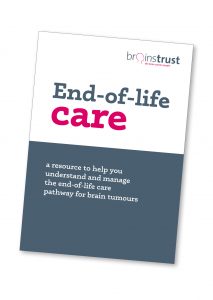Helping you prepare for end-of-life care
Death is the one sure certainty for us all, yet we rarely discuss end-of-life care and what our final wishes would be. Having all the relevant information allows you to open up the conversation, make sure any requests are in place and ensure that you feel in control.
We have produced a comprehensive guide to help you navigate end-of-life care, feel comfortable talking about the topic with your loved ones and ensure that your wishes are met. Join us to talk through the guide and explore practical help at our Managing End-of-life Care webinar on 20 October.
The End-of-life Care Resource
 This resource has been produced with people who have the lived experience of what it is like to care for someone with a brain tumour at end-of-life, with leading consultants in palliative care and clinical nurse specialists who are hospice-based.
This resource has been produced with people who have the lived experience of what it is like to care for someone with a brain tumour at end-of-life, with leading consultants in palliative care and clinical nurse specialists who are hospice-based.
It covers all aspects of what dying with a brain tumour entails. This resource provides information on good end-of-life care, how to achieve it, who can help you and how to ensure that you are being informed and making the right decisions that are personal to you. It will take you through options for stopping treatment through to looking at making decisions for where the patient wants to die. Having as much information to hand as possible allows you to be in control, certain that you are making the right decisions for those concerned.
The guide will give you:
- independent, factual information available on end-of-life care when living with a brain tumour for patients, caregivers and stakeholders
- the information you need so that you can make informed decisions about end-of-life care and how to manage it
- an understanding of what happens in end-of-life care quickly and easily, with evidence supporting the information
- the ability to build trust in clinical judgement and in stakeholder decisions
- the ability to articulate the challenges around end-of-life care so that you can be more open in your discussions.
Click here to find out more, download online copies or request a hard copy of the resource.
Managing end-of-life care: a brainstrust webinar
Do you have questions about end-of-life are? Are you worried about how to communicate effectively and sensitively about death and dying?
We know that the end-of-life care page on our website is one of the most visited pages. To coincide with the launch of our resource on this topic we are running a webinar to provide information on end-of-life care and how to have conversations around this topic.
The webinar will be on 20 October at 11am – please click here to sign up.









